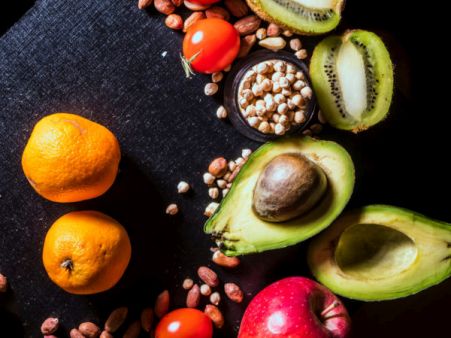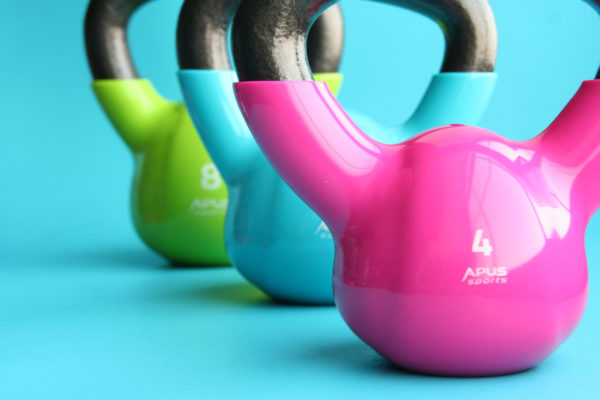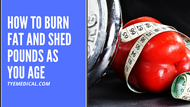Expert Tips for Losing Weight After 40 and Why It Seems So Hard!
Written by tyemedical on Mar 13th 2020
Losing Weight After 40
When it comes to losing weight after 40, you often hear comments or read fatalistic headlines that blame metabolism. “You’re just getting older”. “Your metabolism is tanking”. “Join the club”. So, is the midlife spare tire inevitable? Are you doomed to live with poor health as your risk for heart disease, cancer, and diabetes increases with each extra pound?
The truth? You don’t have to live with extra weight just because you’re not a bubbly 30-year-old anymore. There will be some adjustments, but they are very doable and should give you the results you’re looking for.
The Over 40 Challenge
Losing weight after 40 isn’t all about your metabolism – or even mostly about it. In fact, it plays a very small role in mid-life weight gain. In reality, metabolism slows very little with age.
On a basic level, metabolism is the total energy required for your body to run daily. We need slightly less energy to operate with each passing year, but again, it’s not a drastic change even when combined with changing hormone levels. However, the gradual decrease adds up over time if you’re not monitoring your diet and activity. For example, a 50-year-old woman might suddenly realize she’s gained 15 pounds since age 35 and start to panic about her increasing weight.
So, whatever your age, here are some tips to help you lose the extra pounds or maintain your figure instead of being caught off guard. It can be done.
What can you do?
 1. Avoid Trigger Foods
1. Avoid Trigger Foods
Unless you crave vegetables, which isn’t usually the case, then consider anything you crave to be BAD, not only for your health but also for your waistline. The big culprit for most of us is sugar and simple carbohydrates. The more foods you eat (and drink) containing these triggers, the more you want. Cravings are never satisfied; they’re just temporarily appeased.
So, if losing weight after 40 is your goal, then plan to get serious about avoiding these trigger foods.
Blame it on your brain’s response to sugar (and simple carbs that break down into sugar). They stimulate mental and physical cravings that make you raid the kitchen on a whim or sneak off to a vending machine in the middle of your workday. Ironically, the more you feed the cravings, the worse the cravings become!
While we’re talking about sugar, it’s also important to avoid alcohol or at least seriously limit it. All alcohol is sugar-laden and will pack on the pounds very quickly!
So, how do you stop the vicious cycle? Go cold turkey. Get serious. Stop the sugar train.
Not sure how? Read on!
2. Eat Fruit and Minimally Processed Sugars
Avert your sugar cravings with 3-5 servings of raw fruit each day. Replace sugar and artificial sweeteners with small amounts of Stevia, honey, or maple syrup when necessary. Also, keep some dates in your refrigerator for a quick dose of natural sugar that’s also rich in fiber and other nutrition. But eat these sparingly, because just 2-3 large dates contain about 110 calories!
If you’re a hardcore sugar addict, then you might need to abstain even from these sugars for a couple weeks to avoid replacing one sugar addiction with another. It might be difficult to keep from eating 10 dates in one sitting if your cravings are too strong. In these cases, it’s best to practice a sugar detox and keep away from all forms for 2 weeks at least. Then incorporate fruit and other sources of minimally processed sugar as previously discussed.
In many cases, if you gently indulge your need for sweet with foods containing naturally occurring sugar, then the raging cravings for processed sugar will stop. After 2-3 weeks you’ll break the craving cycle, which is essential to losing weight after 40.
3. Include Whole Grains & Beans
If you love bread and pasta, instead choose a few ½ cup servings of whole grains (brown rice, quinoa, barley, steel-cut oats, millet, buckwheat, etc.) per day, along with a few ½ cup servings of beans (canned and rinsed or fresh cooked) per day.
Whole grains provide the energy you need while stabilizing blood sugar and keeping inflammation at bay. When insulin levels remain steady rather than fluctuating, you experience very few cravings.
Keep in mind that whole grains aren’t flour products, like bread and pasta. Indulge in just 2 servings of pasta a week and eat whole-grain bread occasionally.
Beans have a similar effect as whole grains, providing filling fiber, protein, and complex carbs that don’t spike blood sugar. They’re also rich in folic acid, magnesium, and potassium.
4. Enjoy Healthy Fats

When it comes to losing weight after 40, it’s important to understand healthy fats. You might need to retrain your brain on this one. The truth is – not all fats are bad for you. Even if your goal is to lose weight, consider adding some healthy, monounsaturated and polyunsaturated fats to your diet. These savory additions help you feel more satisfied with your meals, which keeps you from overeating and consuming too many calories. Just remember that a little goes a long way and keep track of how many calories you’re consuming.
Healthy fats for everyone to include:
- Olive oil
- 1 TBS serving, preferably cold pressed
- Nuts (especially walnuts)
- 1/4 cup serving, try them raw to avoid excess salt
- Seeds (chia, hemp, flax)
- 1-3 TBS serving depending on type
- Avocado
- ¼ of whole equals 1 serving
HHealthy fats for non-vegans to include:
- Fish (especially salmon)
- 3 oz serving, preferably wild caught
- Eggs
- 1 whole equals 1 serving
5. Rethink Your Plate
Ideally, a plant-based diet is your best option for weight loss (and general health). If you’re not quite there yet, start by filling half your plate with lightly cooked or raw vegetables, one quarter with lean protein, and one quarter with whole grains. Just go easy on the starchy vegetables, like potatoes and corn. It’s okay to include them but add other non-starchy veggies as well. Veggies are packed with nutrients and fiber that stave off hunger and give your body the nutrition it needs to curb cravings.
6. Track Your Calories
Losing weight after 40 requires some discipline, because it’s not as easy as it used to be when your body was younger and operating more efficiently. Now, you’ll need to do more than just cut sweets (although that’s always a good first step). Calorie counting must become your friend, at least for a little while. Women should aim for a calorie intake of 1500 per day to lose one pound per week, and men should limit calories to 2000 per day to lose one pound per week. Note that these numbers are average and may be slightly higher or lower depending on your size and exercise habits.
If you’re not tracking calories, then you have no idea if your diet plan is helping or hurting your weight loss efforts. The numbers on the scale will make little sense if you don’t know what you’ve eaten, how much, and the number of calories you’ve consumed. Without tracking your intake, it’s impossible to pinpoint the problem and correct it. With no data, there is no improvement.
Today’s calorie-tracking apps are super easy to use, and they even remember your favorite dishes and foods for easy access later. After a couple weeks of tracking calories, most apps have captured all the foods you eat frequently, making calorie tracking a breeze. It can be eye-opening to see what your regular diet really looks like at the end of the week. By logging your calories, your bad dietary habits will become glaringly obvious and you will know exactly where you should be focusing your efforts. You can also search for nutritional information on foods or popular restaurant items within these apps.
Apps to try:
Fitbit
MyFitnessPal
 7. Pair Strength Training with Aerobic/Cardio Workouts
7. Pair Strength Training with Aerobic/Cardio Workouts
Cardio and aerobic exercise help your body slash pounds by getting you in shape, building endurance, and burning calories on the spot. Adding strength training to your weekly exercise routine is a must for weight loss, because your muscles continue to burn calories even after you end your strength-training workout! Paired together, you’ve got a powerful combination.
So, here’s what you need to know.
Aerobic and Cardio Exercise
Aerobic or cardio exercise means any workout that conditions your cardiovascular system. Simply put, it includes workouts that get your heart pumping and your lungs working. Exercise that keeps your heart and lungs consistently performing at increased levels are considered aerobic or cardio.
The term aerobic means “with oxygen” and refers to increased breathing, while cardio refers more to increased heart rate. Both terms apply to exercises such as walking, jogging, swimming, cycling, cardio fitness classes, etc., because both breath and heart rate remain elevated during these types of exercise.
Strength Training
So why include strength training in your weekly workout lineup? It’s key to losing weight after 40. Strength training grows muscle, which increases your metabolic rate (i.e. kicks your metabolism up a notch), and as a major bonus – it burns through belly fat! In other words, it’s not just for guys who want to get buff. It’s for anyone who wants to positively impact their health and achieve a healthy weight.
Men and women tend to gain weight in their abdomen as they enter middle age, which is largely due to hormonal changes relating to estrogen and testosterone. As discussed earlier in this article, even the small or gradual change in hormones adds up over the years if you’re not paying attention. When you gain weight after a certain age, it typically goes straight to the gut, and strength training is a powerful weapon for fighting abdominal fat.
How to Start Your Exercise Routines:
Begin with some cardio walking and work your way up to 50-70 minutes 3 days per week. Start wherever you need to whether it’s 20 minutes, 10 minutes, or less. Gradually increase walking time only when you’re ready, and shoot for your target heart rate. If you’re not interested in tracking your heart rate, you can know you’ve achieved the right intensity if you can’t easily talk while you exercise.
When you’re ready, try adding strength training 2-3 days per week.
Not sure where to start with strength training? For women, we recommend checking for a Curves gym near you. You’ll have all the support you need, including training on their hydraulic-resistance machines that are designed for low impact and less stress on joints.
If you’re a guy or a woman without a convenient Curves location, check out this article from SilverSneakers, A Beginner’s Guide to the Gym. A little guidance will help you feel more confident when you sign up at your local gym.
Remember to talk to your primary care doctor before starting any new exercise routine.
And maybe you’re thinking, “I’m just too busy for the gym and this crazy new exercise routine”, or, “I can’t afford that”. Well don’t worry, we get it. Just do what you can, when you can. Even if you start exercising for just 10 minutes twice a week, it’s better than doing nothing. Ultimately, your results will directly correlate with the time and effort you invest. As you get used to the new routine, you’ll find that it gets easier and easier to work it into your daily life. Remember, the results are worth the effort!
Want Some More Information About Food and Weight Loss?
Try these very similar food plans:
Mediterranean Diet– recommended by many doctors for heart health and overall wellness
Anti-Inflammatory Diet– like the Mediterranean diet but enhanced to combat inflammation, more restrictive on dairy and red meat
Also, refer to our article How to Stick to Your Diet Plan and Embrace Healthier Habits for more tips.
What If the Weight Just Won’t Come Off?
If you’re managing stress, getting adequate sleep, and have been following the above action plan for several months and still aren’t losing weight, then it’s time to talk to your doctor. Certain underlying conditions can prevent weight loss and must be addressed, because losing weight after 40 shouldn’t be impossible.
You can request hormone testing and ask your doctor to begin monitoring your thyroid numbers more closely. Your primary care physician should also discuss other possibilities if test results are normal.
Weight Lose May Improve Incontinence.
If you’re one of over 15 million people in the U.S. with urinary incontinence, you might not realize that losing weight can improve, or even eliminate, symptoms. Extra pounds around the midsection sometimes weakens the pelvic floor muscles that support your bladder, thereby increasing pressure and aggravating incontinence symptoms.
As you take steps toward a healthier you, try some of our premium incontinence products ranging from light incontinence underwear and pads all the way to overnight protection.

